
Made in the USSR Text by Lev Shugurov, oldest moto-auto journalists of Russia, photos from the author’s archive. Forgotten history of racing opposites
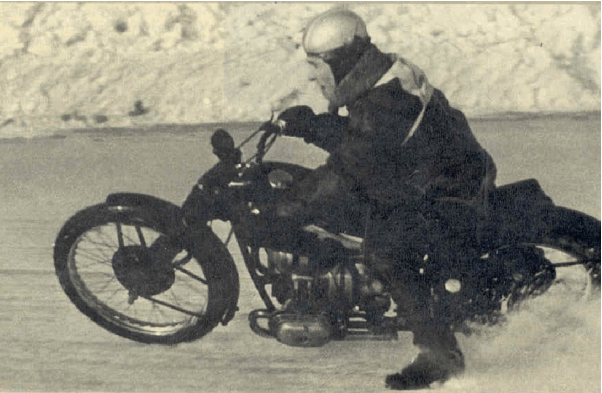
A. Buchin on M-35 during ice track races 1948, front wheel 21″, a typical cylinder head shape and tank cap can be seen.
The origin of Russian opposites is a well-known fact from German BMW R-71, but it has grown some legends. For instance, samples of motorcycles to make copies from were bought via false firms and persons in neutral countries. It may look completely unreasonable why should civil samples be bought secretly indeed when the Germans sold combat-ready “Messerschmitts”? For the reason of preparation of Russia to a war and in such situation even Russian “bast” or “bark shoes” (rus. “lapti”) had a double designation. No one would think though, that besides military and civil use there would appear a third variant, which is hardly remembered now.
“Godfather” of russian opposites is I. Dumulen, an engineer, a tutor of Military academy of motorization and mechanization of the Red Army, sent a report to Soviet government at the beginning of WW2, in which heavy motorcycles were stated necessary for the Army. Basing on the German army war experience, I. Dumulen argued that machines like BMW R-71 would help to fight a potential opponent – German Nazis. This report had a double effect: already in 1941 Moscow bicycle plant had become a main producer of M-72, a soviet variant of BMW R-71, for which engines were made at “ZIS” (now “ZIL”), gear boxes at the “Plant in the name of KIM (“Moskvitch”), while Leningrad and Kiev were preparing for mass-production of such machines. Another effect was that I. Dumulen was arrested for negative speech towards “a friendly state”, but when the army of the “friendly state” reached Moscow in autumn 1941, state punitive services shot quickly all convicts including Dumulen, without any preceeding investigation as urgent evacuation started. Factories that made motorcycles were relocated to the East, M-72 was assembled in Irbit and Gorky towns. At this point a forgotten history of Russian opposites began, a “racing career”. In 1943 A. Fedorov, a main designer at IMZ and a well-known motoracer Igor Okunev started to design a sports version called “M-75″. Okunev debuted in a 300 km country’s championship of the USSR in Tallin, Estonia, A. Lukyanov and N. Sachkov (both from Irbit) won with M-75 competitions in the category of motorcycles with sidecars. So, what was M-75? In fact, same M-72 in overhead valves version with cast iron cylinders mounted to engine casing similarly by cylinders’ flange, valves were positioned in head as V-shape, driven by long pushing rods from central camshaft with same “long” timing as of M-72. Engine’s oiling system remained unchanged, so the new engine was of little costs and same was for chassis. To be absolutely frank, M-77 could hardly fit high sport’s requirements. Supplied in dozens to soviet sports clubs M-75s were tuned, improved and modified by racers on the spot: increased compression ratio, machined valves of bigger diameter, other carburetors, battery ignition changed for magneto. A highly tuned engine would overheat, middle crankshaft was often cracked, most disappointing, for cylinder flange mounted to engine casing would not withstand high loads and brake. The factory knew of these drawbacks and worked on them, thus there appeared M-75M (M has always meant “modernized” in such cases), improved model had magneto ignition,different carburetors, circulating oiling system with separate oil reservior. Such system gave engine a working temperature regime benefits, added by alloy jacketed cylinders(cast iron sleeve was press-fitted into alloy jacket), cylinder heads and cylinders were mounted to the engine casing with long anchor studs, besides, increased valve raise and higher compression ratio had to be accompanied by swollen bottom pistons, a durable design with indents in the bottom for valves. Power output of the engine was increased, though measured were mainly aimed at improving reliability, as only this would give a further way to reach to 45 hp.
Same task was greatly being worked on at Central Experimental Design Bureau in Serpukhov, (Rus. “TsKEB”), later renamed “VNIIMotoprom” and now open joint-stock company “Motoprom”. The bureau engine had higher compression ratio due to cylinder head shape, special design camshaft and increased to 824cc capacity, all resulting in 67,5 hp/6300 rpm, but such indications were reached when the engine was working at its durability limits. This meant the experiment was unsatisfactory. In the meantime craftsmen of Irbit factory made harder clutch springs of 3mm wire instead of 2.7mm previously, took off starter, the gearbox received a breather and a double shoulder gearbox switching lever. Improved front drum brakes should be given their due, increased in diameter, ventilation cut in side covers and each shoe was driven by a separate cam.
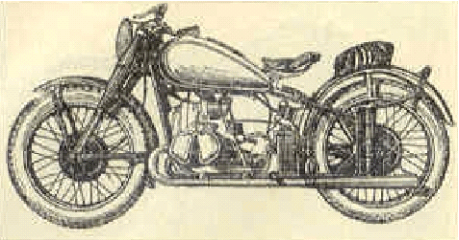
M-75 of IMZ, 1948, features generator, battery, no separate oil tank, each cylinder has two valve covers.
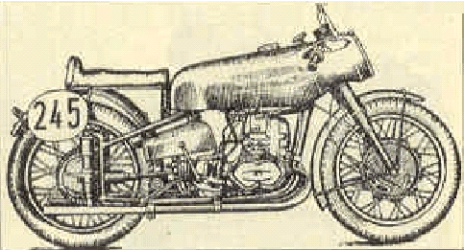
In 1954 IMZ improved the model sufficiently, so M-77 got increased brake drums with both brake shoes driven, fuel tank integrated with fairing, new valve cover.
Beginning in the 1950’s race event rules allowed using spirit-based fuel, so ethanol gave 10-13% of power increase, precisely, M-75M had power increased to 50, with methanol to 55 hp, as fuel consumption increased tremendously to compare with petrol – 12-18l / 100km and 25 liters with methanol, that is 1.5. -2 times more. Practically for a 202 km race circuit (normal distance for country’s championships at that time) one should have used a 50-l fuel tank or had to stop at least once for fueling. Latter was chosen and for faster refueling a new fuel tank cap was designed instead of usual threaded cap. Thus sports clubs got ready for racing machines, used in up to 750cc categories for solo and sidecar variants. Was this the end, you think? Next stage of modernization of sports opposite was M-77 model, it has conventional general design typical for BMW R-71, with opposite engine, duplex frame and cardan shaft final drive. From a racer point of view, Soviet industry could produce only 4.62 ratio variant of final drive tooth wheels, so it hardly possible to swap the tooth wheels choosing different ratio for each race circuit. The chassis received a 35 litre tank integrated with fairing, drum brakes not only made wider, but got parallel cooling fins and bobbin-type throttle handle was installed. Part of IMZ machines were equipped with disk wheels that had no wire spokes. Most of changes were made in engine, now with factory “Lenkarz” carburetors, increased (40 to 43mm) poppet valves diameter gave power rise. Other look of M-77 engine also differed from M-75M with new one-piece valve covers. For road races M-77 as well as its predecessors did not suit, as too wide engine with 756mm cylinder width was a limiting element to go through curves (side valve engine was noticeably narrower -603 mm), in fact M-77, M-75 M-75M engines were not installed into motocross machines, as with such “paddles” there was a great risk of hitting a hillock or stump. Most creative sidecar motocross racers tried a horrible variant – an engine with left side valve cylinder and right overhead valve (this could have been thought in this country only!). Theoretically power of such hybrid engine was 11+18 =29 hp, but unevenly unloaded crankshaft.
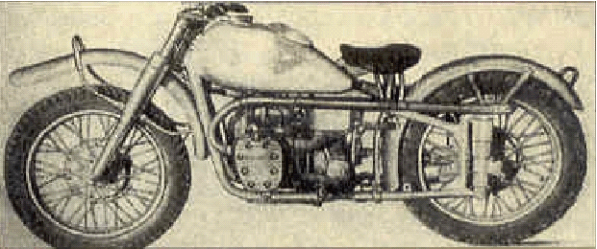
Motocross M-72K with highly raised exhaust pipes, side valve engine, magneto ignition, and big air intake filter with air duct from under saddle.
Special cross machines were issued by IMZ were named M-72K, differing form road version with raised exhaust pipes, higher mounted mudguards, new cover of engine timing mechanism designed to house properly a magneto drive. Also the engine got an effective air filter. Tuning was a moderate one, aimed at increasing torque and working rpm. When IMZ started making a road model M-52 (not for long), there appeared it sports version. By 1957 M-77 and M-75M that were not used for road races, a new M-52C succeeded. Basically it was same M-75 with a 500cc engine, outer distinctive sign of which was a valve cover with three parallel fins. Has there any, even half complete machine survived?
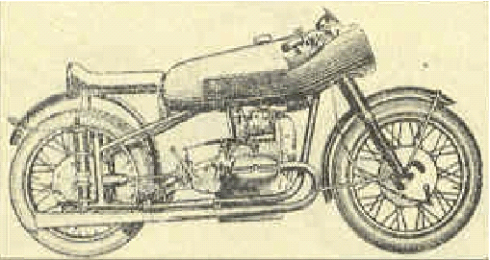
For road races IMZ issued for a short period of time model M-52C with one cam front brake and oiling system similar to M-72 for road races IMZ issued for a short period of time model M-52C with one cam front brake and oiling system similar to M-72.

Racing motorcycle GMZ M-80, 1946, chassis remained similar to M-72, front wheel -21″, rear – 20″
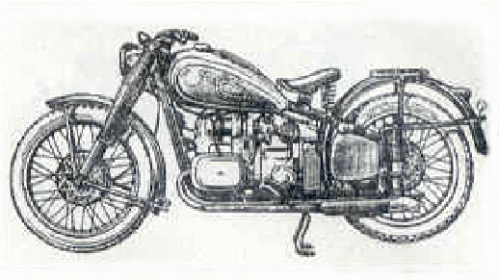
M-35 first had been projected as a road series, with appropriate silencers, lights, saddle type and and cargo rack seen on first experimental sample.
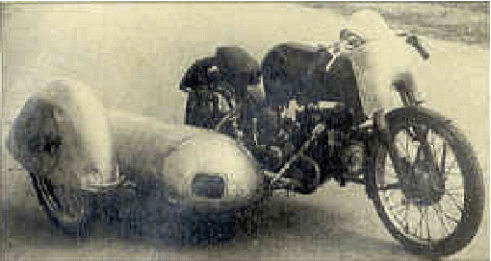
M-35K with sidecar , 1952, equipped with front fairing, wider brake drums and 21″ wheels. Top speed 152kmh.
Now history takes from Siberia to the Volga river, where motoplant of Gorky (“GMZ”) issued its first own design racing model M-80. Two such machines were handed to sports club “Labour Reserves” and in summer 1947 an Honoured master of sport E. Gringaut set an all-Union speed record – 172 km/h. M-80 had same chassis as M-72, a bit lightened and different in some parts, engine shared many similarities with M-72, though engine heads design took after BMW R-75 (“Sahara”). The designer in charge was N.Gutkin, whose most interesting achievement was a racing M-35 of 1947. It chassis took over design of BMW R-71, though in a rather lightened variant, but the engine was different. In general design and parts arrangement it resembles M-75 with a very shallow oil sump, only 145mm rather than 184mm of M-75 and M-72. This was achieved by initially projected “dry engine casing” (oil circulation system) with a separate oil tank. A shallow sump in its turn made the engines’ placing in motorcycle’s frame lower without sacrificing road clearance. The engine had a short-travel dimensions: 61,7x58mm resulting in acceptable width for 350cc class – 660mm, at the same time pushing rods became lighter and shorter. A fine timing setting, valve sizes, combustion chamber form gave some good chance of further engine tuning. Some of these machines had an assembled camshaft to adjust timing easily. Cylinders with alloy jackets and cast iron sleeves, magneto ignition, swollen bottom pistons with thin rings, anchor studs mounting both cylinders and heads were other characteristics of the machine. At the end of 1940’s no other 350cc category engine could have boasted similar perfect design. Both, the motorcycle and and the engine are a great achievement of N. Gutkin. GMZ made only 25 pieces of M-35 and all were spread among motorcycle sports clubs. E. Gringaut and another well-known racer from capital city S. Ovchinkin won the country’s road championship six times with M-35. In many cases racers could have risen power from 20 to 30-31 hp, with methanol fuel it consumed 16-17 l/100 km so it was not surprising that Gringaut’s race machine had a 30 litre fuel tank.
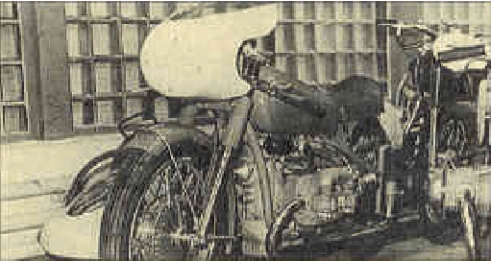
Racing motorcycle of IMZ with chassis M-52C, but engine C-51 made in Serpukhov Dept, on only 3 pieces, each engine head had two camshafts.
The designer Gutkin came to work at Serpukhov experimantal design bureau, which was conducting a vast research on racing and sports motorcycles. According to Gutkin’s project two M-35 with fan-type volume chargers mounted to engine’s front. This gave power increase to 37 hp, an exciting achievement for 1947. So E. Gringaut became a champion of the USSR in 1949 with M-35K.
But the M-35K was redesigned seriously too, by 1949-1950 crank and some other parts were made more durable, the charger could supply a higher pressure (2,1 atm) and raised power to 44 hp at 6600 rpm. E. Kulakov driving a sidecar version of M-35K reached 152,736 km/h. In 1953 the machine got windscreen and fairing, 1 km with flying start it made at 191,082 km/h, which was a new all-Union achievement and beat world record.
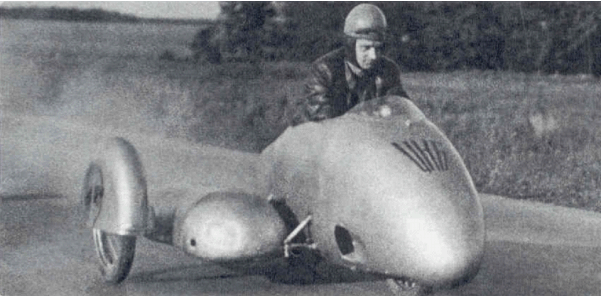
In 1953 Edward Kulakov with sidecar M-35K (350cc category) reached 191kmh in 1 km strip, flying start.
Serpukhov bureau where Gutkin was working made 10 pieces of M-76 , its design was almost same as M-75 of Irbit, but the machines were supplied to sports clubs 4 years earlier. Besides M-76 Serpukhov bureau and IMZ made 3 pieces only of M-51 with opposite 500cc engine and two overhead camshafts for each cylinder. Further work on BMW R-71 design derived sports and racing motorcycles was done Kiev KMZ and Irbit IMZ factories. Up to 1958 machines of similar design were assembled by the racers themselves: Kulakov, Lorent, Silov, Stepanov, Shumilkin, Ermanis. This makes a separate chapter in the history of country’smotorsports.

M-77 most often was used in sidecar races. Pictured Kosmatov and Khokhlov, who from 1954 to 1962 raced on M-77, championships were not held for 750cc solo motorcyles.
Till nowadays IMZ factory still makes motorcycles with OHV engines that prototype design was BMW R-71. Not to miss a sufficient part of the whole history, it must be said that China is still making a sidevalve copy of of the German machine, which is called “Chang Jiang”, based on technical documentation received from the USSR in its time. But what’s a sportman of our opposite now? Only name has left – “a boxer” , called so in the West. A new generation of machines has emerged somehow and the opposites were given their due – glorious memories.
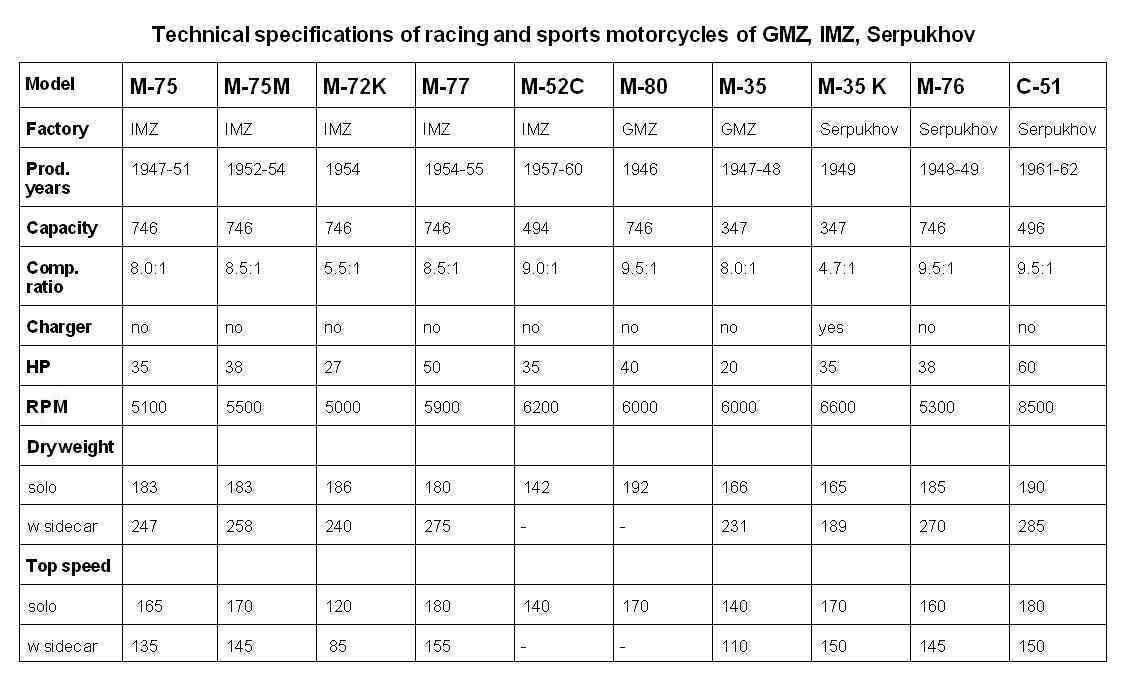
Translation especially for b-cozz by Evgeny Radchenko ©2013
